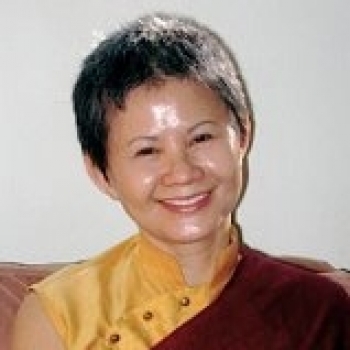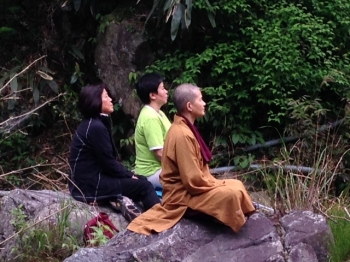Refugee, healer, author, meditation teacher, Buddhist nun, bodhisattva—these are just some of the descriptions of Venerable Dr. Kimle Kalsang. Born into a family of traditional Chinese doctors in Vietnam, Ven. Kalsang fled the communist regime in 1975. She survived a perilous journey on a fishing boat and landed in America in 1979. The new land was a culture shock for the young woman from a poor Vietnamese village, with no money, no family, no friends, and no English skills. To top it all, she found that with no proper documentation, her skills as a doctor were not recognized. Overcoming her initial depression, the fiercely determined Ven. Kalsang set out to earn her accreditation afresh. Refusing government handouts, she took various menial jobs to support herself, and after five years of hardship, was once again able to practice as a Doctor of Traditional Chinese Medicine. Embodying the true bodhisattva spirit of Tibetan Buddhism, Ven. Kalsang has touched and healed many with her deep compassion and medical skills. She has written several books on spiritual development and holistic healing, and has appeared on many television and radio shows. Moreover, on International Women's Day 2014, she was presented with the Outstanding Women in Buddhism Award. Amidst her busy schedule on a recent visit to Singapore, Ven. Kalsang recently shared some of her insights with Shuyin on behalf of Buddhistdoor.
FEATURES
An Interview with Venerable Dr. Kimle Kalsang—Outstanding Women in Buddhism Award Winner, 2014
Buddhistdoor Global | 2015-05-08 |
 From Shuyin
From Shuyin Dr. Kimle Kalsang leading meditation. From Shuyin
Dr. Kimle Kalsang leading meditation. From ShuyinShuyin: What inspired you to be a doctor in Vietnam?
Venerable Kalsang: My father was an excellent and sensitive healer who instilled in me the confidence and all-encompassing compassion that are essential for a great healer. He showed me how to work full-heartedly, to treat each and every patient as my child, my parent, my brother or sister. When the war broke out, my father went to defend the country. I was 16, and began working at a healing center annexed to a temple. Everything was very basic, and we were treating more than 100 people a day. Life was very tough then, and most people were very poor. Sometimes they would bring us rice cakes and bananas as a token of gratitude.
S: You have studied under some of the most accomplished Dharma masters, including the late Chinese Chan master Venerable Hsuan Hua and the late HH Penor Rinpoche, in the Tibetan tradition. How is the Dharma integrated into your work as a healer?
VK: Even at a young age, I had the Dharma in my heart and read many important sutras. When I ordained as a nun in 1980, I realized that this was my true calling—that I had come into this world not to lead a normal life, but to fulfill my bodhisattva vows. Because of my own experiences, I can empathize with the suffering and pain of my patients. True suffering, or what Buddhists call “duhkha,” requires healing that goes beyond the physical. Very often when we get sick, we tackle the problem with prescription drugs and do not look at the root causes. What I offer is the purest and most holistic form of natural healing.
S: How does it work?
VK: I teach the patients to make an overview of their lives, the kind of food they eat, their daily activities, and so on. Over repeated visits, I coach them into changing their habits by deleting the negative elements from their subconscious. I reach into something deeper, something more intrinsic and spiritual—the luminosity inside each one of us. All sicknesses, whether mental or physical, stem from us not being aware of our inner luminosity. Oftentimes, sickness, calamities, and mishaps serve as “wake-up calls”—sickness can be a blessing because it is a sign that the light within you is getting dimmer. It is a message that you have to do something. As a Dharma teacher and a healer, I guide others to empower themselves by rediscovering the power within.
S: What is the best way to deal with pain?
VK: Pain is closely related to the breath—pain comes from the mind, and the mind is regulated by the breath. Pain and conscious breathing cannot take place at the same time, so I coach my patients by teaching them to focus on their breathing. When they do this, they momentarily let go of the pain, and with more practice, the pain will subside. Very often, people like to identify with, and advertise, their pain, and they call up friends and relatives to complain. This just conjures more negative energy and feeds the pain. You cannot solve a problem by going in the same direction; you need to redirect the mind. When you see pain as an enemy, you have a battle to fight. That is combative thinking. But if you learn to see pain as a friend and embrace it by doing gentle breathing, the pain becomes less frightening.
S: Do you find any difficulty reconciling your roles as a doctor and nun?
VK: When I took the 348 vinaya [monastic discipline] vows of a bhikshuni [nun], it was like closing a door. However since I am a healer, immediately afterwards my preceptors bestowed upon me the bodhisattva vows of the Mahayana tradition. The bodhisattva vows opened the door again and allowed me to cultivate bodhichitta-in-action. In this way, I do not break my vows when providing healing to people, even if they are males. Renunciation is a state of mind, a state of non-attachment, of letting go. I can be a nun in a monastery, but if my mind is constantly bombarded with worldly desires, there is no peace. I can be a doctor with a heart embracing the Medicine Buddha and talk about Dharma—the luminosity of mind and awakening primordial wisdom, the infinite wisdom, the infinite compassion, within. I can turn my clinic into a monastery and my healing place into a shrine. This way I am fulfilling my bodhisattva vows.
S: How can we heal the many conflicts and problems that are afflicting the world today?
VK: The disturbances in the world today are no different from those during the Buddha’s time—they only appear more acute because our minds are more complex. The world is a reflection of the confusion in our minds. The Buddha teaches us that “form is emptiness; emptiness is form.” Everything we see is form; all the troubles of the world are form. When you understand this, there is actually no conflict and you can feel at peace. Look at the positive side. Because of the intensity of the problems, more people are being pushed to look inwards, more people are raising their spiritual consciousness. There is so much good work going on to bring about peace, and more people are getting together for good causes such as protecting the environment. Without the mud you never see the lotus. The mud is samsara, and the more intense samsara is, the more intense is the yearning for peace.
S: How about on an individual level?
VK: On an individual level, we can impact the world by how we choose to live our lives and how we think. The mind has the greatest capacity to transform the world. If every one of us can take five minutes each day to think good thoughts and radiate compassion, the vibrational frequency can go very far. If a whole group of people sit together and generate loving kindness, if we can synchronize our hearts, the ripples we send out will soothe the wounds of the world. This is scientifically proven already. Instead of blaming the world for what it is, we are each individually responsible for creating peace and for making a better world.
S: What is the driving force behind your work?
VK: The Buddha himself. He is the practical, impeccable example. The Buddha had no big temple, no decorated monastery. He walked everywhere; he spent much of his life under the trees, with the most meager belongings. The true message the Buddha taught us was an authentic, heartfelt way of living. In my life, I humbly say I try to resemble him in the way I live, and try to be an example for others. Just like the Buddha, we must walk the talk, practice what we preach, and truly be of benefit to all beings.
The Outstanding Women in Buddhism Congress is an organization started in 2001 to recognize Buddhist women and their contributions towards improving the lives of Buddhist women and girls, lobbying for the rights of Buddhist women, in charity work, and in the promotion of the Dharma.

Categories:
Comments:
Share your thoughts:













